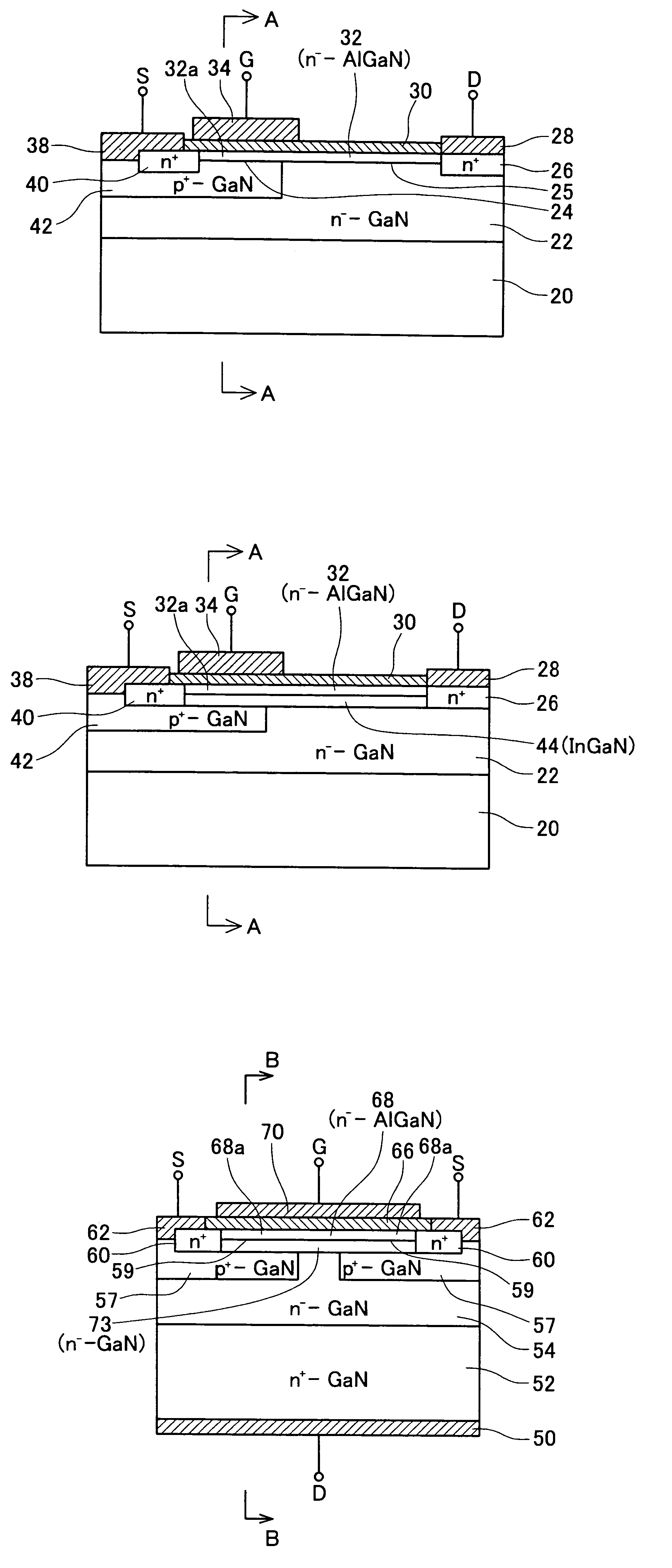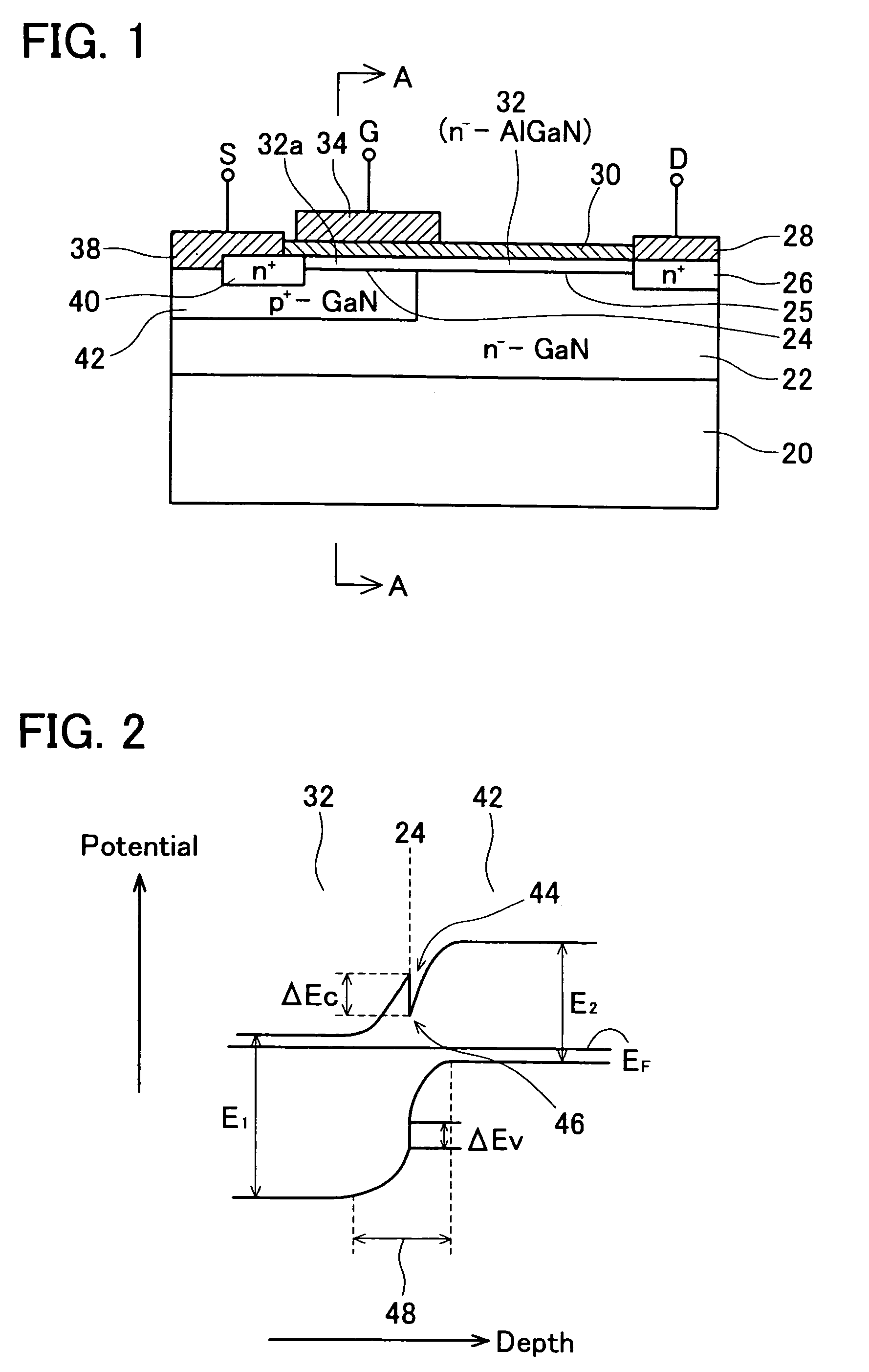Group III nitride semiconductor device
- Summary
- Abstract
- Description
- Claims
- Application Information
AI Technical Summary
Benefits of technology
Problems solved by technology
Method used
Image
Examples
first embodiment
(First Embodiment)
[0060]FIG. 1 is a cross sectional view of a field-effect transistor of the first embodiment. In this transistor, a lower n−-type layer (fourth layer) 22 is formed on a substrate 20. The substrate 20 is composed of Al2O3 (sapphire). The lower n−-type layer 22 is composed of GaN (gallium nitride) doped with Si (silicon), which is an n-type dopant. The concentration of carriers in the lower n−-type layer 22 is about 1×1016 cm−3. The thickness of the thickest portion of the lower n−-type layer 22 is about 5 μm. A p+-type layer (second layer) 42 is formed on the region, which is part of the lower n−-type layer 22. The p+-type layer 42 is composed of GaN doped with Mg (magnesium which is a p-type dopant). The concentration of carriers in the p+-type layer 42 is about 1×1018 cm−3. The thickness of the thickest portion of the p+-type layer 42 is about 0.5 μm. Ge (germanium) or the like may be also doped as the n-type dopant. Be (beryllium) or the like may also be doped as ...
second embodiment
(Second Embodiment)
[0081]The field-effect transistor of the second embodiment shown in FIG. 5 is different from that of the first embodiment mainly in the aspects as follows. In the second embodiment, a channel layer (third layer)44 is provided between the upper n−-type layer 32 and the p+-type layer 42. The channel layer 44 is also continuously provided between the upper n−-type layer 32 and the lower n−-type layer 22. The channel layer 44 is composed of true InGaN that was not doped with dopant. Indium is introduced in the channel layer 44. As a result, the band gap of the channel layer 44 is made smaller than the band gaps of the upper n−-type layer 32 and the p+-type layer 42.
[0082]In the second embodiment, the fabrication can be conducted by removing the first mask layer by virtue of a process similar to that of the first embodiment, then successively growing the channel layer 44 and the upper n−-type layer 32 by the MOCVD method over the entire lower n−-type layer 22 and p+-ty...
third embodiment
(Third Embodiment)
[0085]The field-effect transistor of the third embodiment shown in FIG. 7 has a left-right symmetrical structure of a longitudinal transistor in which a source electrode is formed on the front surface (first surface) of the device and a drain electrode is formed on the rear surface (second surface) of the device. A lower n−-type layer (part of the fourth layer) 54 is formed on an n+-type drain layer (part of the fourth layer) 52. The n+-type drain layer 52 and the lower n−-type layer 54 are composed of GaN that was doped with Si as an n-type dopant. However, the n+-type drain layer 52 was doped with Si to a higher concentration than the lower n−-type layer 54. The concentration of carriers in the n+-type drain layer 52 is about 3×1018 cm−3. The concentration of carriers in the lower n−-type layer 54 is about 1×1016 cm−3. The thickness of the n+-type drain layer 52 is about 200 μm. The thickness of the thickest portion of the lower n−-type layer 54 is about 6 μm. A ...
PUM
 Login to View More
Login to View More Abstract
Description
Claims
Application Information
 Login to View More
Login to View More - R&D
- Intellectual Property
- Life Sciences
- Materials
- Tech Scout
- Unparalleled Data Quality
- Higher Quality Content
- 60% Fewer Hallucinations
Browse by: Latest US Patents, China's latest patents, Technical Efficacy Thesaurus, Application Domain, Technology Topic, Popular Technical Reports.
© 2025 PatSnap. All rights reserved.Legal|Privacy policy|Modern Slavery Act Transparency Statement|Sitemap|About US| Contact US: help@patsnap.com



